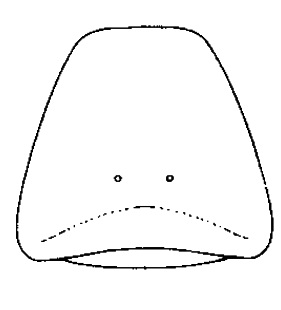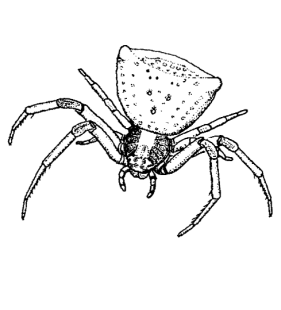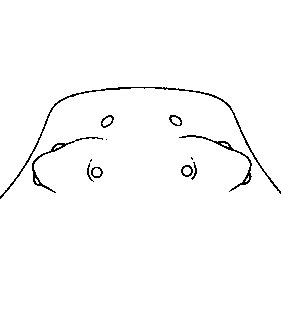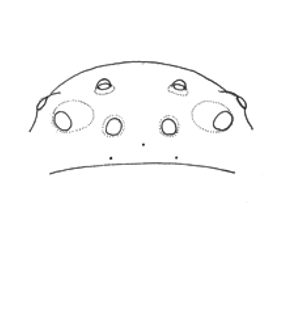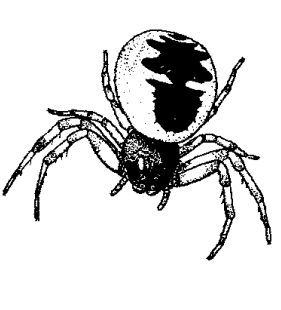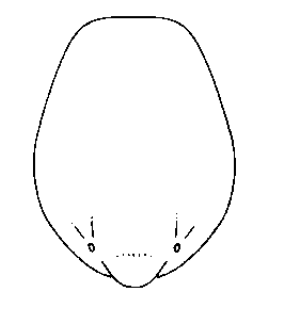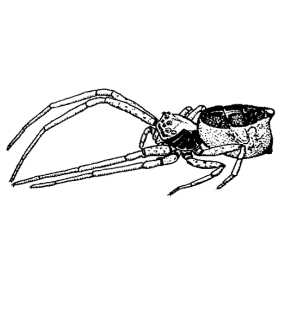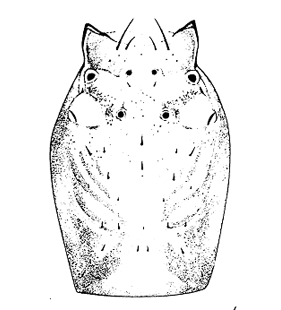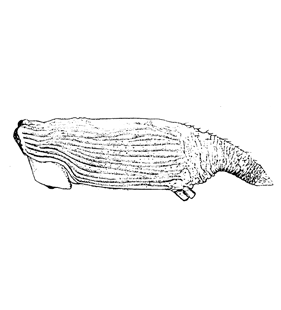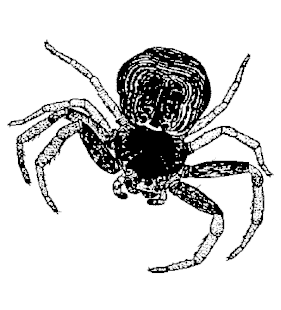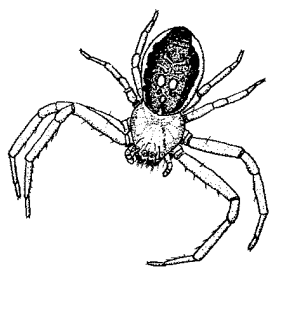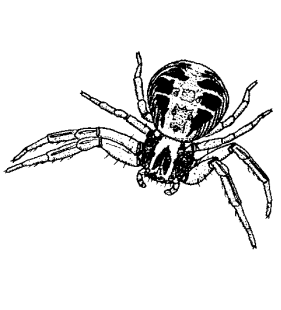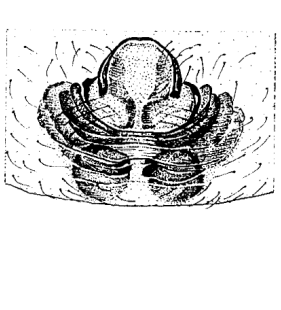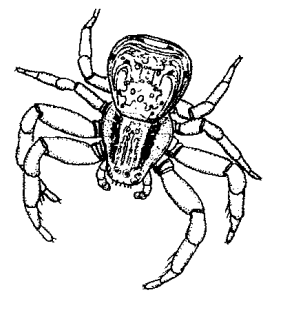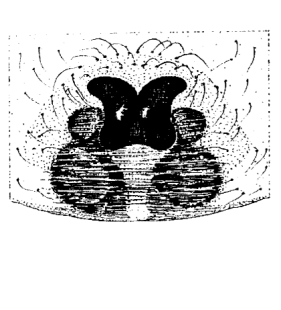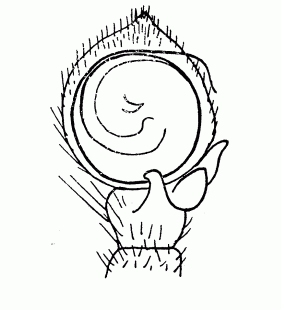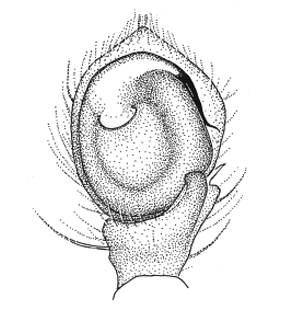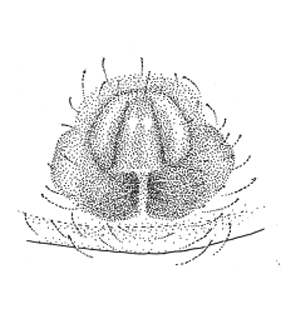Family Thomisidae Sundevall, 1833
Key not complete! Further genera listed at the end of key |
In case you find an error or have a specific suggestion, please follow this link: click
|
|||||||
| 1 |
Posterior part of the opisthosoma angularly widened; lateral eyes on each side on a shared prosomal protrusion |
|||||||
| - | Different | |||||||
| 2 (1) |
Colouration red-brown to grey-black; opisthosoma as fig.; mainly on shrubs. |
| ||||||
| - | Colouration of males pale yellow to yellow-green, females white, yellowish or pink; often on flowers; habitus and eye position as fig. |
| ||||||
| 3 (1) |
Prosoma and legs shiny brown-black; opisthosoma rounded like a lens, bright yellow, dorsally with variable black pattern |
| ||||||
| - | Different | |||||||
| 4 (3) |
The whole body covered with long off-standing hairs; colouration bright green (rarely bright yellow), sometimes prosoma with one, opisthosoma with 3 bright longitudinal stripes (colour bleaches in alcohol); habitus as fig. |
| ||||||
| - | Different | |||||||
| 5 (4) |
Anterior lateral eyes and posterior lateral eyes on a shared protrusion | |||||||
| - | Anterior lateral eyes and posterior lateral eyes on separated protrusions |
|||||||
| 6 (5) |
Distance between anterior median eyes equals distance between posterior median eyes; colouration of male prosoma and legs brown-black, opisthosoma brighter; females mostly white or yellow, opisthosoma laterally sometimes with red or brown stripes; often couching on flowers |
| ||||||
| - | Distance between anterior median eyes is smaller than distance between posterior median eyes; colouration of prosoma and legs yellowish or green, male opisthosoma brown with bright medium stripe; female opisthosoma yellow-greenish with brown markings |
| ||||||
| 7 (5) |
Opisthosoma with a caudal tail-like prolongation or posterior part tip-like elevated |
|||||||
| - | Different |
|||||||
| 8 (7) |
Opisthosoma elevated, posterior part wedge-shaped; brown-grey, adopted to bark |
| ||||||
| - | Prosoma distinctly longer than wide, opisthosoma long and slender, dorsally flat, posterior part cone-shaped, very elongated, extending beyond spinnerets, legs thick and very long |
| ||||||
| 9 (7) |
A hump between the lateral eyes; habitus as fig. |
| ||||||
| - | Different | |||||||
| 10 (9) |
Anterior eye row nearly straight; clypeus height equals one diameter of the anterior median eyes; body strongly flattened; colouration brown with fine yellowish pattern; under bark |
| ||||||
| - | Anterior eye row clearly bent; clypeus height equals + 2 diameters of the anterior median eyes; body not remarkably flattened | |||||||
| 11 (10) |
Prosoma and legs green (rarely reddish), colour bleaches in alcohol; opisthosoma creamy yellow, dorsally with brown pattern |
| ||||||
| - | Colouration primarily yellow, brown, grey or black | |||||||
| 12 (11) |
Width of the median eye quadrangle larger or equally its length; tibia I ventrally at least with 4 pairs of spines; body hairs always pointed; opisthosoma mostly with distinct dark pattern; body length of males 3-7 mm, of females 5 -10 mm; habitus as fig. |
| ||||||
| - | Width of the median eye quadrangle smaller than its length; tibia I ventrally with 2 pairs of spines; body hairs pointed or club-shaped; body length of males 2-4 mm, of females 3-6 mm |
|||||||
| 13 (12) |
Male pedipalpus with tegular apophysis, epigyne with hoods, body length 2 – 6 mm |
| ||||||
| - | Male pedipalpus without tegular apophysis, cymbium with well-developed tutacular groove for the apex of the embolus, male opisthosoma with weakly limited scutum, covering 2/3 of the opisthosoma, epigyne without hoods, epigynal plate with massive outgrowth, vulva without ducts, body length 2.5 – 4 mm |
| ||||||
| - | Further species: Only one male has been described from this species, and since 1895 no more specimens were collected. Only France and Spain. Firmicus bivittatus |
| ||||||
| - | Further species: Since the first collection of both sexes, 1952 in Azerbaijan, no further specimens were identified. Misumenops armatus |
|||||||
| - | Further subspecies: Only one subspecies in Europe (France): Bassaniana versicolor baudueri |
|
Further genera
- 1. Bassaniodes
- 2. Pherecydes
- 3. Psammitis
- 4. Spiracme
